Turning my backyard into a garden [EN/FR]
Hello gardeners! I am finally starting the creation of my first vegetable garden, after a lot of thinking about what to grow. So, I have an idea of the seeds I will buy and how many I will grow. I am also leaving a little room for improvisation because after all, we are talking about nature, it is good not to control everything!
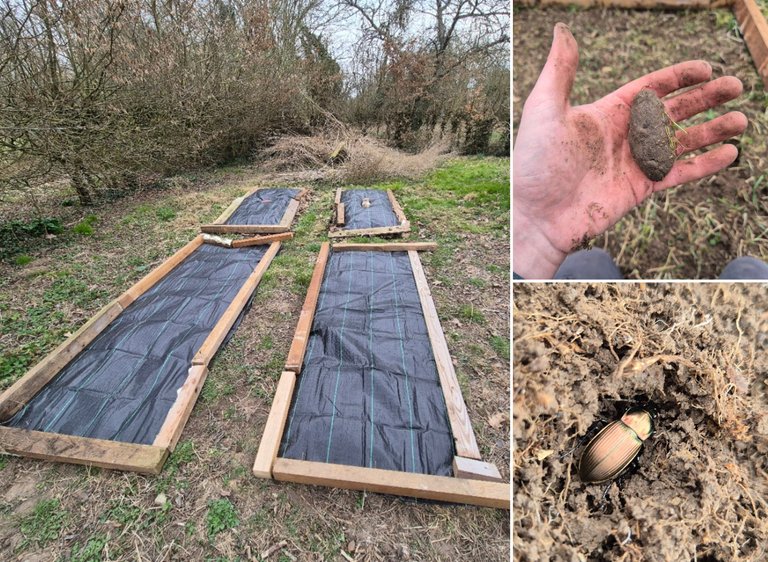
Finding a place to put your vegetable garden is also finally very complicated for a novice. You see everything on the Internet:
- You must avoid putting it too close to a hedge or under a tree.
- Not too close to a building.
- It is good to have a little shade on a part of the cultivated plot for vegetables that need it.
- Etc.
All this is theory. But in reality, you have to deal with what you have around you. On our side, with @altheana, when our finances allow us, we will have a septic tank installed in the garden. So to avoid having to remove the vegetable garden when we do the work, that takes away a large part of the garden that we can cultivate.
We then had 2 options:
- In front of the house, right in front of the kitchen window.
- Next to a kennel that had been set up by former owners, at the back of the garden.
We opted for the second option because if we opted for the first, it meant that we could not install a summer terrace.

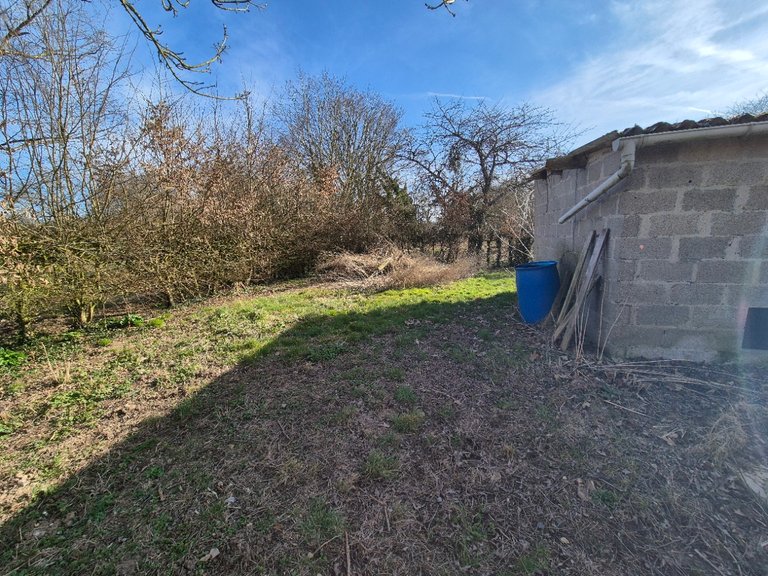
Here is the location of our future vegetable garden:
- Close to a hedge.
- Close to a tree.
- And almost in the shadow of a building.
We will see what it will give. Hoping that everything goes well for us. In summer, the sun will be much higher in the sky, so we should have more light in the vegetable garden. For the moment, we are still at the end of winter.

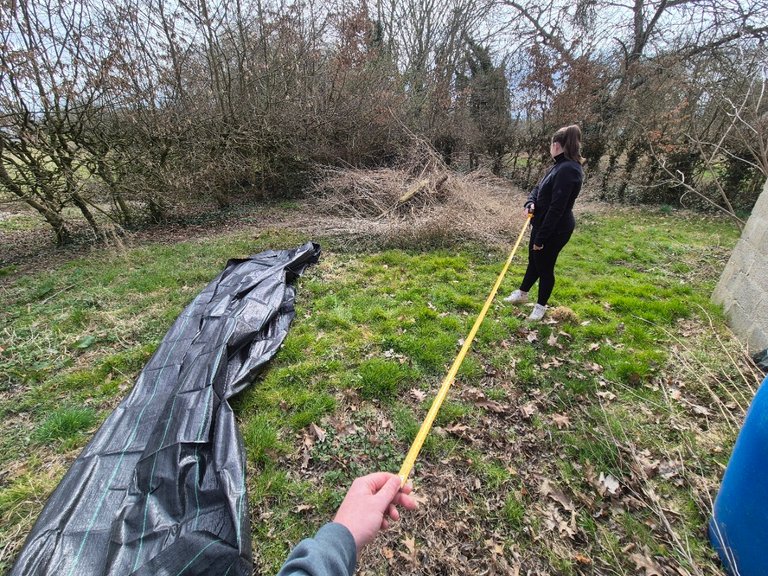
We bought a rectangular tarp of 2m by 5m that we decided to cut into 4. We will therefore have 4 distinct plots and it will be easier to walk between them.
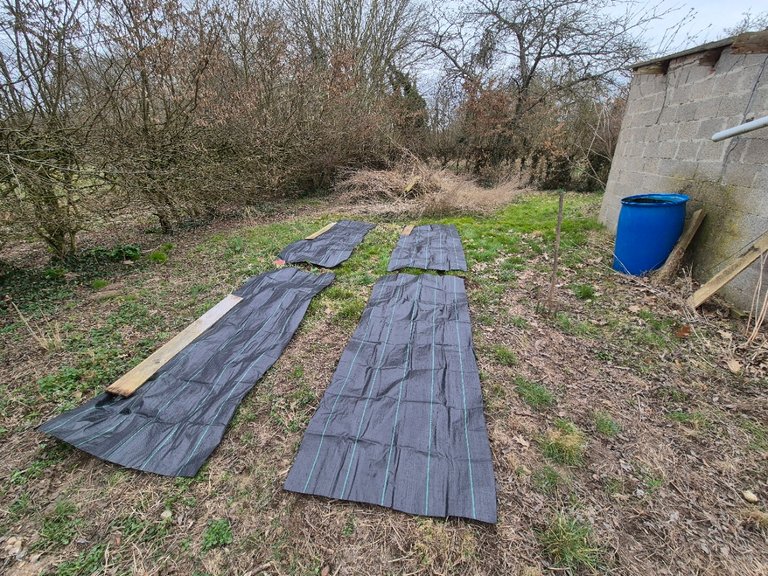
After cutting the tarp into 4 pieces, we found reclaimed boards to delimit the plots. These are boards that we recovered from the old shed in front of the house that we dismantled.

Once the plots were properly delimited, we had to work the soil a little. At least, cut the grass short, aerate the soil with a broadfork, and put a pile of leaves on each plot before tarping for 3 to 4 weeks (before making the first plantings).
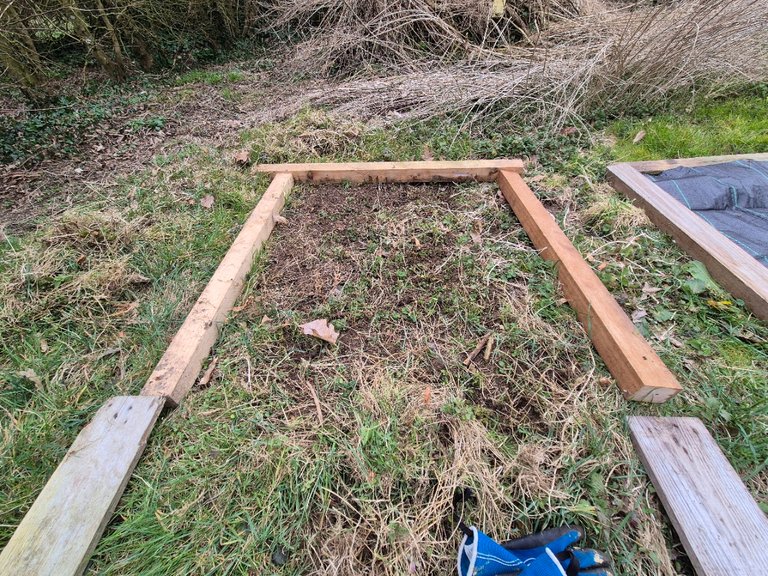
We did not have a mower to remove the 10 cm of wild grass, so we did it by hand.

Apparently, the most important thing when making a vegetable garden is to know the composition of your soil. From what I have read, there are different types of soil:
- Clay soil (retains water and nutrients well but compacts easily, is poorly drained, and difficult to work).
- Loamy soil (fertile and easy to work but sensitive to erosion and can form surface crusts).
- Sandy soil (easy to work but poor in nutrients).
For each type of soil, different mulches should be added. According to my sausage test, which is not really a reliable test, my soil would be between loamy and clayey. That is to say, I can form the sausage easily, but after a while, it breaks.
In our case, we should therefore add compost and mulch to improve its structure. We have none of that, but we have leaves, which should do the trick.
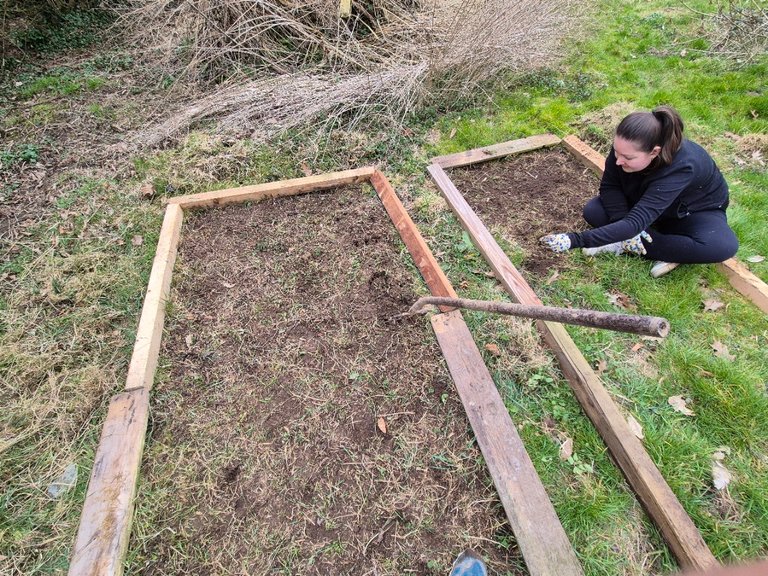

We did not have a broadfork, so we used a fork to aerate the soil. The principle remains the same, you push the fork into the ground and lift.
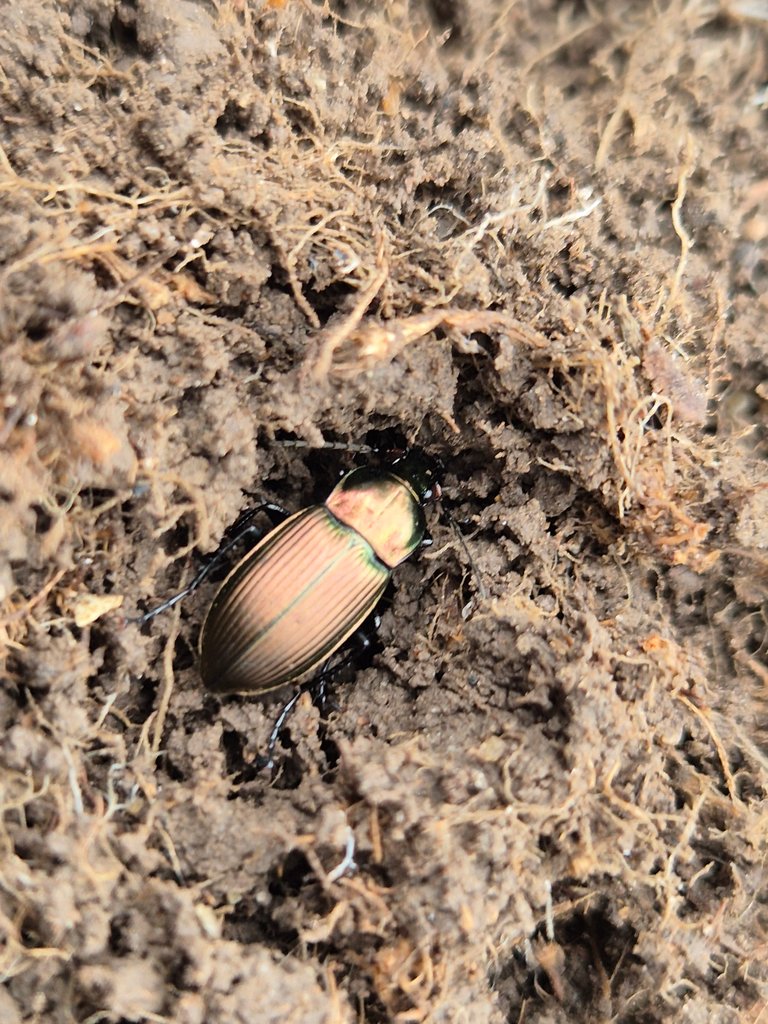
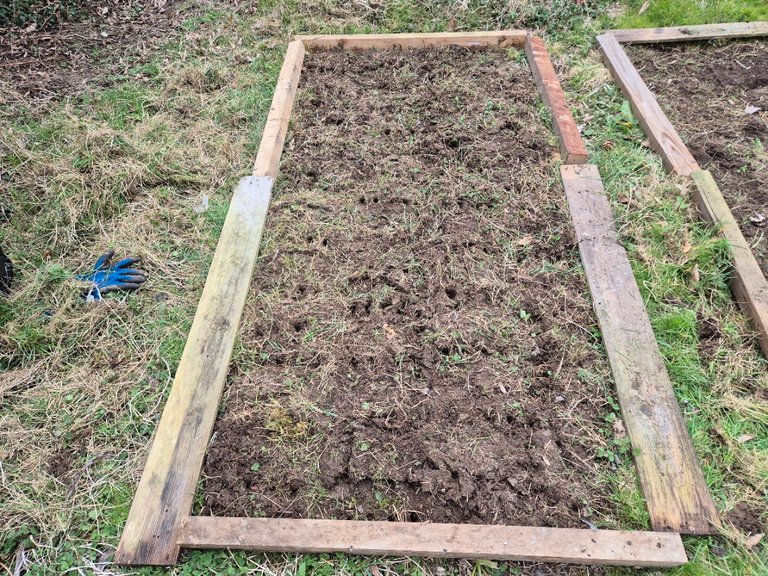
Once the first two plots were prepared, we added a thick layer of leaves. As they decompose, they will enrich the soil with organic matter and nutrients (nitrogen, phosphorus, potassium).

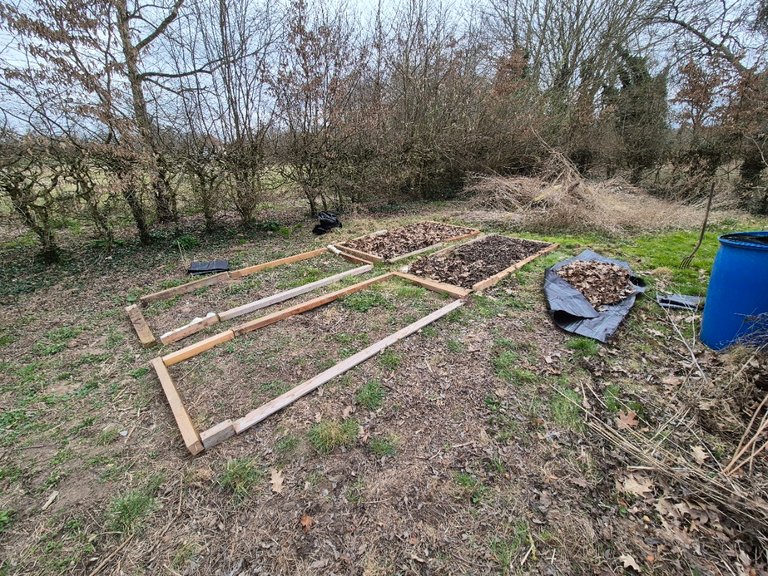
We still had 2 left to do, but since it was getting late and we had a lot of things to do in the house, we simply tarped the plots we did not have time to work on. By limiting the light, it should prevent the grass from growing, making our work easier when we can take care of it.

And for the two at the back that we worked on well, we also put a tarp over them. It will retain heat and moisture, which should speed up the decomposition of the leaves. I saw that the ideal is to do it with cardboard (removing the tape to avoid plastic and avoiding the parts of the cardboard with ink). Because the cardboard can also decompose and will in turn promote soil life.
Now all I have left to do is prepare my seedlings! I ordered several from a site and now I am waiting for the delivery.
Version Française
Bonjour les jardiniers ! Je me lance enfin dans la création de mon premier potager, après beaucoup de réflexion quant à quoi faire pousser. J'ai donc une idée des graines que je vais acheter et combien je vais en faire pousser. Je laisse aussi une petite place à l'improvisation car après tout, on parle de nature, il est bon de ne pas tout contrôler !

Trouver un endroit où mettre son potager est aussi finalement très compliqué pour un novice. On voit de tout sur Internet :
- Il faut éviter de le mettre trop proche d'une haie ou sous un arbre.
- Pas trop à côté d'un bâtiment.
- Il est bon d'avoir un peu d'ombre sur un bout de la parcelle cultivée pour les légumes qui en ont besoin.
- Etc.
Tout ça est de la théorie. Mais dans la réalité, il faut faire avec ce qu'on a autour de nous. De notre côté, avec @altheana, lorsque nos finances nous le permettront, nous allons faire installer une fosse septique dans le jardin. Donc pour éviter de devoir retirer le potager lorsque nous ferons les travaux, ça nous enlève une grosse partie du jardin que nous pouvons cultiver.
Il nous restait alors 2 options :
- Devant la maison, juste devant la fenêtre de la cuisine.
- A côté d'un chenil qui avait été monté par des anciens propriétaires, au fond du jardin.
Nous avons opté pour la seconde option car si nous options pour la première, ça voulait dire qu'on ne pourrait pas installer de terrasse d'été.


Voici donc l'emplacement de notre futur potager :
- Proche d'une haie.
- Proche d'un arbre.
- Et presque dans l'ombre d'une habitation.
On verra ce que ça donnera. En espérant que tout se passe bien pour nous. En été, le soleil sera beaucoup plus haut dans le ciel, nous devrions donc avoir plus de lumière dans le potager. Pour le moment, nous sommes encore à la fin de l'hiver.


Nous avons acheté une bâche rectangulaire de 2 m sur 5 m que nous avons décidé de couper en 4. Nous aurons donc 4 parcelles distinctes et il sera plus facile de se balader entre ces dernières.

Après avoir coupé la bâche en 4 morceaux, nous avons trouvé des planches de récupération pour délimiter les parcelles. Ce sont des planches que nous avons récupérées de l'ancien appentis devant la maison que nous avons démonté.

Une fois les parcelles correctement délimitées, il fallait qu'on travaille un peu la terre. Au moins, qu'on coupe l'herbe à ras, qu'on aère le sol avec une grelinette et qu'on mette un tas de feuilles sur chaque parcelle avant de bâcher pour 3 à 4 semaines (avant de faire les premières plantations).

Nous n'avions pas de tondeuse pour retirer les 10 cm d'herbes sauvages et l'avons donc fait à la main.

Apparemment, le plus important quand on fait un potager, c'est de connaître la composition de son sol. De ce que j'ai pu lire, il existe différents types de sols :
- Terre argileuse (retient bien l'eau et les nutriments, mais se compacte facilement, est mal drainée et est difficile à travailler).
- Terre limoneuse (fertile et facile à travailler, mais sensible à l'érosion et peut former des croûtes en surface).
- Terre sableuse (se travaille facilement mais est pauvre en nutriment).
Pour chaque type de sol, il conviendra de lui ajouter différents paillages. D'après mon test du boudin, qui n'est pas vraiment un test fiable, ma terre serait entre limoneuse et argileuse. C'est-à-dire que je peux former le boudin facilement, mais qu'au bout d'un moment, il se casse.
Dans notre cas, nous devrions donc lui ajouter du compost et du paillage pour améliorer sa structure. Nous n'avons rien de tout ça, mais nous avons des feuilles, ce qui devrait faire l'affaire.


Nous n'avions pas de grelinette, alors nous avons utilisé une fourche pour aérer le sol. Le principe reste le même, on enfonce la fourche dans le sol et on soulève.


Une fois les deux premières parcelles préparées, nous y avons ajouté une épaisse couche de feuilles. En se décomposant, elles vont enrichir le sol en matière organique et en nutriments (azote, phosphore, potassium).


Il nous en reste 2 à faire, mais puisqu'il commençait à se faire tard et que nous avions beaucoup de choses à faire dans la maison, nous avons simplement bâché les parcelles que nous n'avons pas eu le temps de travailler. En limitant la lumière, ça devrait éviter que l'herbe ne pousse, ce qui facilitera notre travail lorsque nous pourrons nous en occuper.

Et pour les deux du fond que nous avons bien travaillées, nous avons aussi mis une bâche par-dessus. Elle va retenir la chaleur et l'humidité, ce qui devrait accélérer la décomposition des feuilles. J'ai vu que l'idéal est de le faire avec du carton (en retirant le scotch pour éviter le plastique et en évitant les parties du carton où il y a de l'encre). Car le carton peut lui aussi se décomposer et favorisera à son tour la vie du sol.
Il ne me reste maintenant plus qu'à préparer mes semis ! J'en ai commandé plusieurs sur un site et j'attends à présent la livraison.
The English translation was done using the DeepL API, and the images were taken with my smartphone.
Posted Using INLEO
This post has been manually curated by @steemflow from Indiaunited community. Join us on our Discord Server.
Do you know that you can earn a passive income by delegating to @indiaunited. We share more than 100 % of the curation rewards with the delegators in the form of IUC tokens. HP delegators and IUC token holders also get upto 20% additional vote weight.
Here are some handy links for delegations: 100HP, 250HP, 500HP, 1000HP.
100% of the rewards from this comment goes to the curator for their manual curation efforts. Please encourage the curator @steemflow by upvoting this comment and support the community by voting the posts made by @indiaunited.
Searching for information on any topic on the internet is a safe bet to waste time and end up with more doubts than before starting, hehe. You have done well to prepare the future orchard where you have room, as you work with it you will learn and the results will be better. It's hard to get it right on the first try, but I wish you a fruitful harvest anyway. I hope to see you around here.
I have picked this post on behalf of the @OurPick project! Check out our Reading Suggestions posts!
Please consider voting for our Liotes HIVE Witness. Thank you!
In a French podcast, a comedian said: "During Covid, many Parisians bought second homes in the countryside to make vegetable gardens, and all failed. It's like a farmer going to Paris to become a lawyer; he'll probably fail at first."
It all comes from experience! 😁😃
That's right! No matter how much theory you study, until you try you don't know what it really is. And the more you fail, the more you will learn. 😘
!LOL
Your post has been manually reviewed for curation by the Principality of Bastion.
Check the Trail of posts we voted
Principality of Bastion - Our Leit Motiv? Let's Grow Together.
Principality's site | Minava NFT Market | Discord | Our Twitch Channel
You may TRAIL this account if you like the curation we do, or join our discord to know more about what we do.

lolztoken.com
He had no chance against all 5 of us.
Credit: reddit
@genesisledger, I sent you an $LOLZ on behalf of itharagaian
(4/10)
Delegate Hive Tokens to Farm $LOLZ and earn 110% Rewards. Learn more.
!LOLZ
lolztoken.com
Mediocrates
Credit: reddit
@genesisledger, I sent you an $LOLZ on behalf of hive-103505
(5/10)
Farm LOLZ tokens when you Delegate Hive or Hive Tokens.
Click to delegate: 10 - 20 - 50 - 100 HP
Hello, hey, good start, you chose a good place, at least the plants you are going to plant are ready for transplanting, this way you won't have problems with ants, because when we plant seeds we first have to eliminate all those ant burrows, I wish you much success in your garden.
Yes, you're right. There aren't many ants around here. According to my neighbors, the problem comes from slugs in the region 😁
You have undertaken a great project, @genesisledger, and it appears you have gotten off to a good start. There is something about gardening and growing our own food which brings some welcome peace of mind, in the challenging world around us.
I wish you well, with the start of a new growing season, to get your plants in and up into the light. For us, we find that to be the most difficult part of the growing season. Once planted and we begin to see them appear and thriving, the rest becomes a nice opportunity to get outside on a regular basis and play in the dirt! 🫡
Your comment is upvoted by @topcomment
Info - Support - Discord
Thank you kindly, @topcomment. It is always encouraging and affirming to hear from you! 🫡
congratulations with starting your new garden. I know it can be hard when starting out with challenging soil but, with time & amendments everything should work out. I have found that there are certain plants grow well and others don't in the soil we have here and so I focus on those plants.
Indeed, the best advice I have received so far is to know your land well!
It is interesting what you show us. At the beginning I didn't know how you would use plastic and now I do. Good tip.
Yes, it creates a greenhouse effect and retains moisture, promoting soil decomposition 👌👍